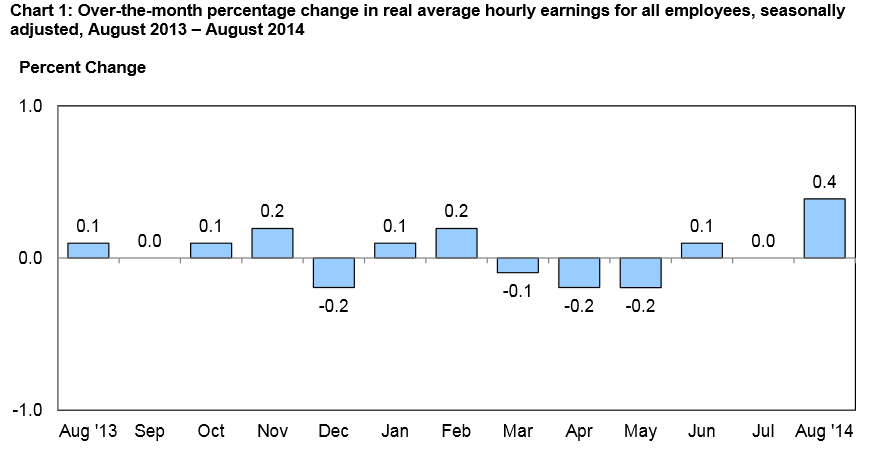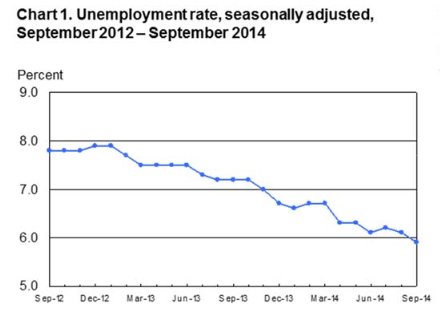Employment Blog October 2014
This report is from the Bureau of Labor Statistics Monthly Employment Report. Nonfarm payroll employment rose by 248,000 in September, and the unemployment rate declined to 5.9 percent. Employment increased in professional and business services, retail trade, and health care. Incorporating the revisions for July and August, which increased total nonfarm payroll employment by 69,000 on net, monthly job increases have averaged 224,000 over the past 3 months. In the 12 months prior to September, employment growth averaged 213,000 per month.
This information is summarized in Charts 1 and 2 below.
Professional and business services added 81,000 jobs in September, compared with an average monthly gain of 56,000 over the prior 12 months. In September, job gains occurred in employment services (+34,000), management and technical consulting services (+12,000), and architectural and engineering services (+6,000).
Retail trade employment rose by 35,000 in September. Most of the increase occurred in food and beverage stores (+20,000), largely reflecting the return of workers who had been off payrolls in August due to employment disruptions at a grocery store chain in New England. Over the year, retail trade employment has increased by 264,000.
Employment in health care increased by 23,000 in September. Over the month, job gains occurred in home health care services (+7,000) and in hospitals (+6,000). Over the year, health care has added 256,000 jobs.
In September, the information industry added 12,000 jobs, with a gain of 5,000 in telecommunications. Over the year, employment in information has shown little net change.
Among other service-providing industries, employment in food services and drinking places and in financial activities continued to trend up in September (+20,000 and +12,000, respectively).
In the goods-producing sector, mining employment rose by 9,000 in September and is up by 50,000 over the year. Construction employment continued on an upward trend in September (+16,000). Within the industry, residential building gained 6,000 jobs. Over the year, construction employment has grown by 230,000. Employment in manufacturing showed little change over the month.
Turning to measures from the survey of households, the unemployment rate declined in September by 0.2 percentage point to 5.9 percent. Over the year, the jobless rate is down by 1.3 percentage points. In September, there were 9.3 million unemployed persons, a decrease of 329,000 from August. The number of long-term unemployed (those unemployed 27 weeks or more) was essentially unchanged over the month, at 3.0 million.
The labor force participation rate, at 62.7 percent, changed little in September. The employment-population ratio remained at 59.0 percent; it has been at this level for 4 consecutive months.
Among the employed, the number of people working part time for economic reasons was little changed at 7.1 million in September. (These individuals, also referred to as involuntary part-time workers, would have preferred full-time employment, but had their hours cut or were unable to find full-time work.)
Among people who were neither working nor looking for work in September, 2.2 million were classified as marginally attached to the labor force, about unchanged over the year. (These individuals had not looked for work in the 4 weeks prior to the survey but wanted a job, were available for work, and had looked for a job within the last 12 months.) The number of discouraged workers, a subset of the marginally attached who believed that no jobs were available for them, was 698,000 in September, a decline of 154,000 over the year.
Real average hourly earnings for all employees (adjusted for inflation) increased by 0.4 percent from July to August, seasonally adjusted, the U.S. Bureau of Labor Statistics reported today. This increase stems from a 0.2 percent increase in the average hourly earnings and a 0.2 percent decrease in the Consumer Price Index for All Urban Consumers (CPI-U). The change in real average hourly earnings is the largest 1-month percentage increase since November 2012. Real average weekly earnings in creased by 0.4 percent over the month due to the increase in real average hourly earnings and an unchanged average workweek.
Chart 3 below details the last 12 months of real hourly earning growth. 


